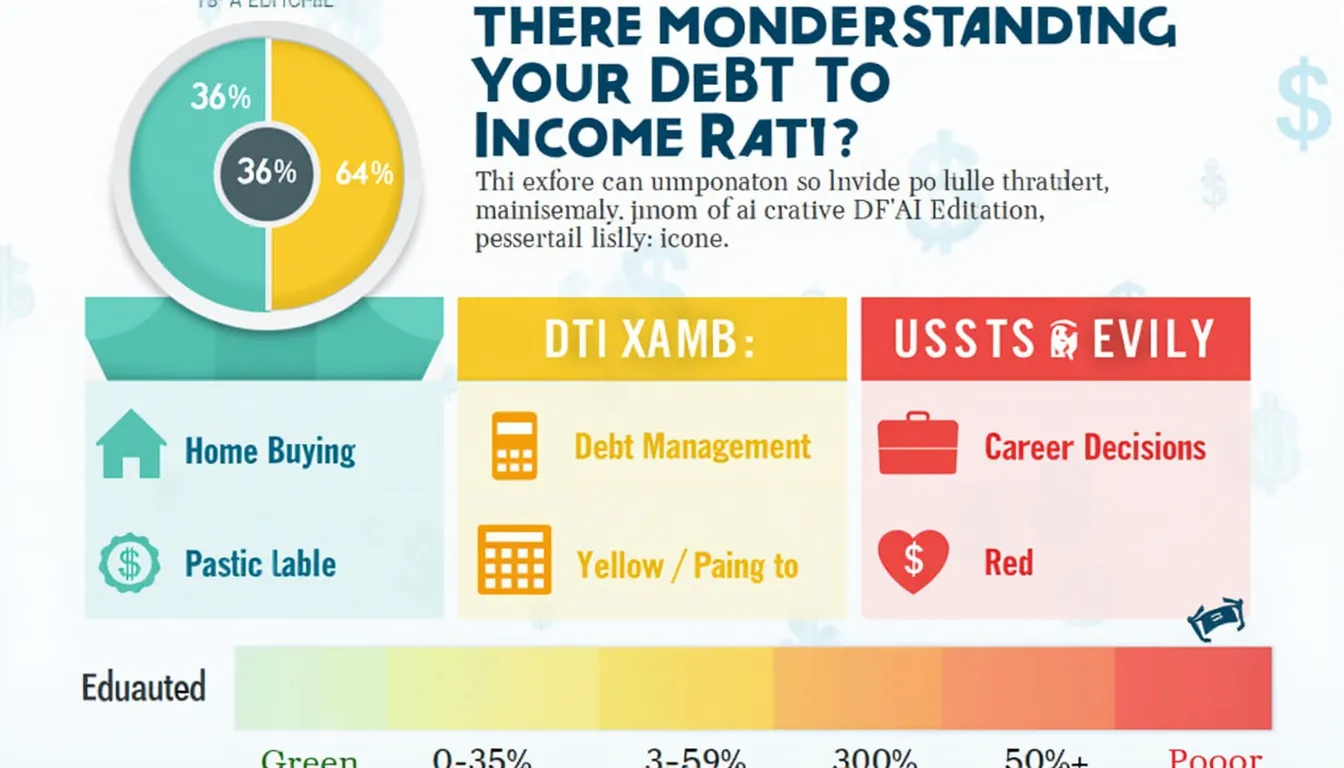Debt-to-Income Ratio Calculator
Is this tool helpful?
How to Use the Debt-to-Income (DTI) Ratio Calculator Effectively
Our Debt-to-Income (DTI) Ratio Calculator is designed to help you quickly assess your financial health by comparing your monthly debt obligations to your income. Here’s a step-by-step guide on how to use this tool effectively:
Step 1: Enter Your Total Monthly Debt Payments
In the first field, input the sum of all your monthly debt payments. This should include:
- Mortgage or rent payments (e.g., $1,200)
- Car loan payments (e.g., $300)
- Student loan payments (e.g., $250)
- Credit card minimum payments (e.g., $150)
- Personal loan payments (e.g., $100)
- Any other recurring debt obligations (e.g., alimony or child support: $100)
For example, if your total monthly debt payments add up to $2,100, enter this amount in the “Total Monthly Debt Payments” field.
Step 2: Input Your Gross Monthly Income
In the second field, enter your gross monthly income. This is your total income before taxes and other deductions. Include:
- Salary or wages (e.g., $5,000)
- Overtime pay (e.g., $500)
- Bonuses or commissions (if received regularly)
- Rental income (e.g., $600)
- Any other consistent sources of income
For instance, if your monthly salary is $5,000 and you earn an additional $600 from rental property, enter $5,600 in the “Gross Monthly Income” field.
Step 3: Add Any Additional Monthly Income (Optional)
If you have any other regular income sources that weren’t included in your gross monthly income, you can add them in the “Additional Monthly Income” field. This might include:
- Part-time job earnings (e.g., $400)
- Investment income (e.g., $200)
- Alimony or child support received (if not already included)
For example, if you earn $400 from a part-time job and receive $200 in investment income, you could enter $600 in this field.
Step 4: Calculate Your DTI Ratio
Once you’ve entered all the required information, click the “Calculate DTI Ratio” button. The calculator will process your inputs and display your Debt-to-Income Ratio as a percentage.
Step 5: Review Your Results
After calculation, you’ll see your DTI ratio, along with a category (Low, Moderate, or High) and a personalized recommendation based on your result. Take time to read through this information to understand your financial standing and potential next steps.
Understanding Debt-to-Income Ratio: Your Financial Health Indicator
The Debt-to-Income (DTI) ratio is a crucial financial metric that provides insight into your overall financial health. It’s a simple yet powerful tool used by both individuals and lenders to assess one’s ability to manage monthly payments and repay debts.
What is the Debt-to-Income Ratio?
The DTI ratio is a personal finance measure that compares your monthly debt payments to your monthly gross income. It’s expressed as a percentage and represents the portion of your income that goes towards paying debts.
The Mathematical Formula
The DTI ratio is calculated using the following formula:
$$
\text{DTI Ratio} = \frac{\text{Total Monthly Debt Payments}}{\text{Gross Monthly Income}} \times 100\%
$$
Purpose and Benefits of Calculating Your DTI Ratio
Understanding your DTI ratio offers several benefits:
- Financial Self-Awareness: It provides a clear picture of your current financial situation.
- Loan Qualification: Lenders use this ratio to determine your ability to manage monthly payments and repay debts.
- Budgeting Tool: It helps you understand how much of your income is already committed to debt payments.
- Financial Goal Setting: Knowing your DTI ratio can help you set realistic financial goals and track your progress.
- Early Warning System: A rising DTI ratio can be an early indicator of potential financial stress.
Benefits of Using Our DTI Ratio Calculator
Our DTI Ratio Calculator offers numerous advantages for individuals seeking to understand and improve their financial health:
1. Quick and Accurate Calculations
Manual calculations can be time-consuming and prone to errors. Our calculator provides instant, accurate results, saving you time and ensuring reliability.
2. User-Friendly Interface
The intuitive design makes it easy for anyone, regardless of their financial background, to input their information and understand the results.
3. Comprehensive Input Options
Our calculator allows you to include various types of debts and income sources, providing a more accurate representation of your financial situation.
4. Instant Categorization
The tool automatically categorizes your DTI ratio as Low, Moderate, or High, giving you immediate insight into your financial standing.
5. Personalized Recommendations
Based on your DTI ratio, the calculator provides tailored recommendations to help you improve or maintain your financial health.
6. Financial Planning Aid
By regularly using this calculator, you can track changes in your DTI ratio over time, helping you make informed decisions about taking on new debts or focusing on debt reduction.
7. Loan Preparation Tool
If you’re considering applying for a loan, this calculator can help you understand how lenders might view your financial situation, allowing you to take steps to improve your DTI ratio if necessary.
How Our DTI Ratio Calculator Addresses User Needs
Our DTI Ratio Calculator is designed to address several key user needs and solve specific financial problems:
1. Financial Health Assessment
Many individuals struggle to get a clear picture of their financial health. Our calculator provides a quick, objective measure of your debt burden relative to your income.
Example Calculation:
Let’s say John has the following financial situation:
- Monthly mortgage payment: $1,500
- Car loan payment: $400
- Credit card minimum payments: $200
- Student loan payment: $300
- Gross monthly income: $6,000
Using our calculator:
- Total Monthly Debt Payments: $1,500 + $400 + $200 + $300 = $2,400
- Gross Monthly Income: $6,000
The calculator would determine John’s DTI ratio as:
$$
\text{DTI Ratio} = \frac{\$2,400}{\$6,000} \times 100\% = 40\%
$$
The calculator would categorize this as a “Moderate” DTI ratio and provide recommendations for improvement.
2. Loan Qualification Insights
For those considering applying for a loan, our calculator helps users understand how lenders might view their financial situation.
Example Scenario:
Sarah is considering applying for a mortgage. Her current financial situation is:
- Monthly rent: $1,000
- Car loan payment: $300
- Credit card payments: $150
- Gross monthly income: $5,500
Using our calculator:
- Total Monthly Debt Payments: $1,000 + $300 + $150 = $1,450
- Gross Monthly Income: $5,500
The calculator would determine Sarah’s current DTI ratio as:
$$
\text{DTI Ratio} = \frac{\$1,450}{\$5,500} \times 100\% = 26.36\%
$$
This “Low” DTI ratio suggests Sarah is in a good position to apply for a mortgage, as most lenders prefer a DTI ratio below 36% for home loans.
3. Debt Management Planning
Our calculator helps users understand the impact of their debts on their overall financial health, aiding in debt management planning.
Example Scenario:
Mike wants to understand how paying off his credit card debt would impact his DTI ratio. His current situation:
- Monthly mortgage payment: $1,200
- Car loan payment: $350
- Credit card payments: $400
- Gross monthly income: $4,800
Current DTI ratio:
$$
\text{DTI Ratio} = \frac{\$1,200 + \$350 + \$400}{\$4,800} \times 100\% = 40.63\%
$$
If Mike pays off his credit card debt:
$$
\text{New DTI Ratio} = \frac{\$1,200 + \$350}{\$4,800} \times 100\% = 32.29\%
$$
This calculation shows Mike how significantly reducing his credit card debt could improve his DTI ratio, moving him from a “Moderate” to a “Low” category.
Practical Applications of the DTI Ratio Calculator
Our DTI Ratio Calculator has numerous practical applications in various financial scenarios:
1. Home Buying Process
When preparing to buy a home, understanding your DTI ratio is crucial. Most mortgage lenders prefer a DTI ratio of 36% or less, with some allowing up to 43% for qualified borrowers.
Example:
Emma is planning to buy her first home. Her financial situation:
- Current rent: $1,100
- Car loan: $300
- Student loan: $250
- Credit card payments: $100
- Gross monthly income: $5,500
Using our calculator, Emma’s current DTI ratio is:
$$
\text{DTI Ratio} = \frac{\$1,100 + \$300 + \$250 + \$100}{\$5,500} \times 100\% = 31.82\%
$$
This “Low” DTI ratio suggests Emma is in a good position to apply for a mortgage. She can use this information to estimate how much she might be able to afford in monthly mortgage payments while keeping her DTI ratio below 36%.
2. Debt Consolidation Decision Making
For individuals considering debt consolidation, the DTI ratio can help in making an informed decision.
Example:
Tom has multiple high-interest debts and is considering a debt consolidation loan. His current situation:
- Mortgage: $1,400
- Car loan: $350
- Credit card 1: $200
- Credit card 2: $150
- Personal loan: $300
- Gross monthly income: $6,000
Current DTI ratio:
$$
\text{DTI Ratio} = \frac{\$1,400 + \$350 + \$200 + \$150 + \$300}{\$6,000} \times 100\% = 40\%
$$
If Tom consolidates his credit card and personal loan debts into a single loan with a monthly payment of $500:
$$
\text{New DTI Ratio} = \frac{\$1,400 + \$350 + \$500}{\$6,000} \times 100\% = 37.5\%
$$
This calculation shows how debt consolidation could slightly improve Tom’s DTI ratio, potentially making it easier to manage his debts.
3. Career Decision Support
The DTI ratio can be a valuable tool when considering career changes or negotiating salaries.
Example:
Lisa is considering a job offer that would increase her gross monthly income from $4,000 to $4,500. Her current debts include:
- Rent: $900
- Car loan: $250
- Student loan: $300
Current DTI ratio:
$$
\text{DTI Ratio} = \frac{\$900 + \$250 + \$300}{\$4,000} \times 100\% = 36.25\%
$$
DTI ratio with new job:
$$
\text{New DTI Ratio} = \frac{\$900 + \$250 + \$300}{\$4,500} \times 100\% = 32.22\%
$$
This calculation shows Lisa how the new job would improve her DTI ratio, potentially enhancing her overall financial health.
Frequently Asked Questions (FAQ)
Q1: What is considered a good Debt-to-Income ratio?
A: Generally, a DTI ratio of 36% or less is considered good. Here’s a breakdown:
- 35% or less: Excellent
- 36% to 49%: Good to Fair
- 50% or higher: Poor
Q2: How often should I calculate my DTI ratio?
A: It’s a good practice to calculate your DTI ratio at least once a year, or whenever there’s a significant change in your income or debt situation.
Q3: Does my credit score affect my DTI ratio?
A: No, your credit score and DTI ratio are separate financial metrics. However, both are often considered by lenders when evaluating loan applications.
Q4: Should I include my spouse’s income and debts in the DTI calculation?
A: If you’re applying for a joint loan, you should include both incomes and all debts. For individual financial assessment, use your personal income and debts.
Q5: How can I improve my DTI ratio?
A: You can improve your DTI ratio by:
- Increasing your income (e.g., getting a raise, taking on part-time work)
- Paying off existing debts
- Avoiding taking on new debts
- Refinancing existing debts to lower monthly payments
Q6: Are there any debts that shouldn’t be included in the DTI calculation?
A: Generally, you should include all recurring monthly debt payments. However, expenses like groceries, utilities, and insurance premiums are typically not included in DTI calculations.
Q7: Can my DTI ratio affect my ability to rent an apartment?
A: While landlords typically focus more on credit scores, some may consider your DTI ratio. A lower DTI ratio can make you appear more financially stable to potential landlords.
Q8: Is it possible to have a 0% DTI ratio?
A: Yes, it’s possible if you have no monthly debt payments at all. However, this is uncommon and not necessarily ideal, as responsible use of credit can help build a good credit history.
Q9: How do lenders use the DTI ratio?
A: Lenders use the DTI ratio to assess your ability to manage monthly payments and repay the money you plan to borrow. It helps them determine the level of risk in lending to you.
Q10: Should I include my mortgage payment in my DTI ratio if I’m applying for a new mortgage?
A: When applying for a new mortgage, lenders typically calculate two DTI ratios: one with your current housing expense (front-end DTI) and one with the proposed mortgage payment (back-end DTI). Our calculator can help you estimate both scenarios.
Important Disclaimer
The calculations, results, and content provided by our tools are not guaranteed to be accurate, complete, or reliable. Users are responsible for verifying and interpreting the results. Our content and tools may contain errors, biases, or inconsistencies. We reserve the right to save inputs and outputs from our tools for the purposes of error debugging, bias identification, and performance improvement. External companies providing AI models used in our tools may also save and process data in accordance with their own policies. By using our tools, you consent to this data collection and processing. We reserve the right to limit the usage of our tools based on current usability factors. By using our tools, you acknowledge that you have read, understood, and agreed to this disclaimer. You accept the inherent risks and limitations associated with the use of our tools and services.







